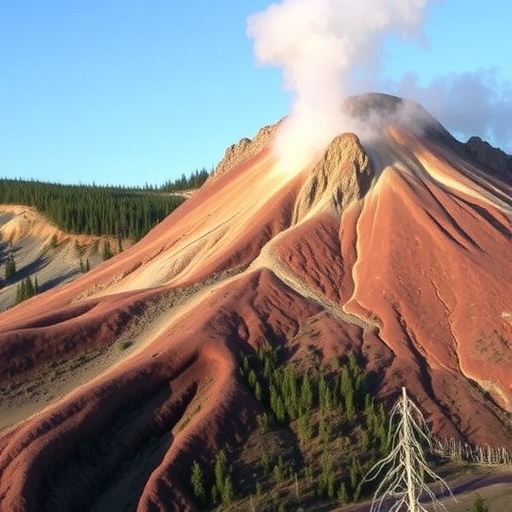
Deep beneath the Yellowstone caldera lies one of Earth’s most enigmatic and hazardous volcanic systems, whose stability has long captivated volcanologists and geophysicists alike. Recent groundbreaking research has unveiled new insights into the uppermost magma storage beneath this iconic landscape, revealing a previously undetected sharp reflective boundary within the magmatic reservoir approximately 3.8 kilometers beneath the surface. This discovery offers unprecedented detail about how volatile-rich materials—gases dissolved in magma—accumulate and behave at these shallow depths, significantly advancing our understanding of volcanic processes that influence eruption potential.
For decades, scientists have sought to constrain the depth and volatile content of the shallow magma chambers underneath Yellowstone. These magma reservoirs are critical to volcanic stability because the exsolution—or release—of volatiles from the magma can influence pressure buildup and, consequently, the triggering of eruptions. The volatile exsolution process begins as magma ascends and pressure decreases, causing dissolved gases like water vapor, carbon dioxide, and sulfur compounds to form bubbles. However, capturing the precise conditions and physical properties of the magma reservoir’s upper cap has remained challenging due to the complex interaction of fluids, crystals, and gases in the subsurface.
The recent deployment of controlled-source seismic imaging techniques has revolutionized this picture by resolving a distinct and abrupt reflective boundary atop the Yellowstone magma reservoir. Seismic waves, generated and recorded across this area, reveal that the top of the reservoir hosts a heterogeneous mix of supercritical fluid and molten rock filling the pore spaces within a low-shear-velocity zone extending from roughly 3 to 8 kilometers deep. This supports the notion that volatile exsolution and bubble formation are not merely diffuse background processes but can concentrate sharply near the magma reservoir’s upper limit.
One of the most striking aspects of this discovery is how it corroborates theoretical models predicting localized bubble accumulation near the upper boundaries of magma chambers, driven by decompression-induced volatile saturation. When magma rises to these relatively shallow levels beneath the caldera, the pressure drop prompts volatiles to separate from the melt and generate a bubbly foam layer. Such accumulation, if unchecked, can lead to buoyancy-driven instability, potentially speeding magma ascent or producing pressure pulses that trigger eruptive events. However, the seismic data suggest that, at Yellowstone, this bubbly layer is currently both sharp and stable.
The bubble volume fraction—the proportion of the magma reservoir’s pore space occupied by gas bubbles—estimated from the seismic reflections is notably lower than previously predicted values associated with rhyolitic pre-eruptive conditions. This implies that while bubble formation is active, it does not presently reach the critical thresholds likely to promote reservoir destabilization. Importantly, this stability is attributed to the reservoir’s character as a crystal-rich mush with less than 30% porosity, where interconnected pathways allow bubbles to escape efficiently rather than accumulate excessively. This creates a dynamic balance that prevents the buildup of dangerous pressures beneath the caldera.
Supporting this interpretation, independent studies of Yellowstone’s expansive hydrothermal system document substantial release of magmatic volatiles, notably carbon dioxide emissions that feed into surface fumaroles and diffuse degassing sites. These emissions illustrate an effective “outgassing” mechanism where volatile-rich fluids migrate from magmatic depths into the shallower crust and atmosphere, relieving internal pressures within the magma reservoir. Such continuous flux aligns with the seismic evidence for channelized bubble ascent and fluid migration, underscoring a coupled system where degassing and seismic structure reflect the magmatic-hydrothermal interplay.
These insights build upon and refine earlier work that mapped the Yellowstone magma reservoir’s spatial extent and composition using seismic tomography and geophysical monitoring. While previous models estimated a broad, low-velocity zone in the upper crust indicative of partially molten rock, the new reflective boundary resolution clarifies the fine-scale stratification at the reservoir’s top. This stratification includes a mixture of supercritical fluids—a state of matter at pressures and temperatures where distinctions between gas and liquid phases blur—and viscous magma interspersed with gas bubbles, all critical to understanding eruption mechanics.
The implications of identifying a stable, volatile-rich cap at Yellowstone are far-reaching. Understanding how magmatic volatiles are retained or released informs eruption forecasting and hazard assessment, particularly for a supervolcano capable of producing calamitous eruptions. The findings suggest that the current state of the magma reservoir is less prone to rapid destabilization via bubble over-accumulation than previously feared. Instead, the system appears to dissipate volatiles steadily, preventing sudden pressure increases that could otherwise precipitate explosive activity.
Nevertheless, the delicate balance maintained at the magma reservoir’s cap could shift with changes in magma supply, volatile content, or crustal stress. Long-term monitoring and integration of seismic, geochemical, and petrological data remain vital to detect any evolution toward instability. The ongoing supply of volatile-rich magma from Yellowstone’s mantle source, coupled with crystal-rich magma storage conditions, points to a dynamic regime where bubble ascent channels may reorganize, possibly impacting eruption likelihood over centuries to millennia.
This research stands as a testament to the power of advanced seismic imaging to unveil hidden volcanic architecture and processes that control eruption dynamics. By integrating physical seismology with petrological models of degassing and crystallinity, scientists are now better equipped to interpret the signatures of subsurface magmatic systems and assess volcanic risk. Particularly in regions like Yellowstone, where hazardous supervolcanic activity looms as a global concern, improved knowledge of magma degassing pathways and reservoir stability offers critical tools for crisis preparedness.
Furthermore, the discovery invites revision of conventional models that often portray magma chambers as homogenous bodies; instead, the reservoir is more accurately viewed as a crystal-rich mush harboring discrete layers where gas and melt phases coexist in complex equilibrium. This heterogeneity influences not only eruption triggers but also the transmission of volcanic signals such as seismicity, ground deformation, and gas emissions observed at the surface. Recognizing and quantifying these subtle internal features enhances the scientific foundation for volcanic surveillance.
In conclusion, the identification of a sharp, volatile-rich cap atop Yellowstone’s magma reservoir represents a major advance in volcanology. It elucidates how magmatic systems partition and release volatiles at critical depths, balancing bubble formation against ascent and outgassing. This balance underpins the current stability of one of Earth’s most spectacular volcanic systems, with vital implications for eruption forecasting and hazard mitigation. As seismic imaging continues to refine our view beneath active volcanoes, our capacity to anticipate and respond to volcanic hazards will likewise evolve, enhancing the safety and resilience of vulnerable populations.
Subject of Research:
Volatile exsolution and magma reservoir stability beneath Yellowstone Caldera
Article Title:
A sharp volatile-rich cap to the Yellowstone magmatic system
Article References:
Duan, C., Song, W., Schmandt, B. et al. A sharp volatile-rich cap to the Yellowstone magmatic system. Nature (2025). https://doi.org/10.1038/s41586-025-08775-9
Image Credits:
AI Generated
Tags: deep Earth processesexsolution of volatiles in magmagases dissolved in magmageophysical research on volcanoesmagma storage beneath Yellowstoneseismic imaging techniques in geologyshallow magma chambersunderstanding Yellowstone calderavolatile-rich cap in magmavolcanic eruption potentialvolcanic stability factorsYellowstone volcanic system


